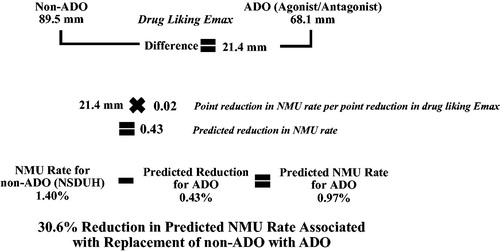Figures & data
Figure 1. Estimated reductions in non-medical use. Abbreviations. ADO, abuse-deterrent opioid; Emax, mean maximum effect; NMU, non-medical use; NSDUH, National Survey on Drug Use and Health. This figure reflects calculation steps for agonist/antagonist ADOs only. Physical barrier ADOs have a drug liking Emax of 80.4 mm, resulting in a 12.7% reduction in predicted NMU rate. The difference in drug liking Emax was converted to point reductions in NMU according to White et al.Citation12 and used to calculate the percent reduction in predicted NMU rate. Notes: (1) ‘mm’ represents millimeters, which are one unit on the Drug Liking scale measured from 0–100. (2) The 30.6 percent reduction in the predicted NMU rate associated with replacement of a non-ADO with an ADO is calculated by dividing the predicted percentage point reduction in the NMU rate associated with replacement of a non-ADO with an ADO (∼0.43 percentage points) by the NMU rate associated with non-ADO as reported by the NSDUH (∼1.40 percentage points).

Table 1. Key model inputs.
Table 2. Estimated annual avoided medical events and costs.Table Footnotea
Table 3. Overall medical cost savings and avoided ED visits.
